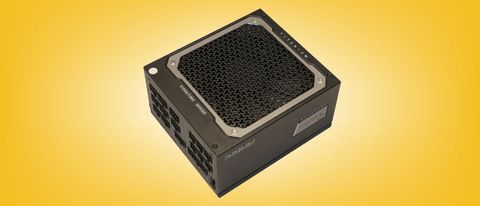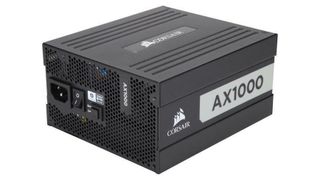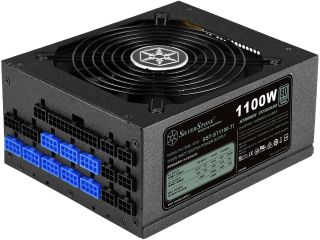Why you can trust Tom's Hardware
To learn more about our PSU tests and methodology, please check out How We Test Power Supply Units.
Primary Rails and 5VSB Load Regulation
The following charts show the main rails' voltage values recorded between a range of 40W up to the PSU's maximum specified load, along with the deviation (in percent). Tight regulation is an important consideration every time we review a power supply because it facilitates constant voltage levels despite varying loads. Tight load regulation also, among other factors, improves the system’s stability, especially under overclocked conditions and, at the same time, it applies less stress to the DC-DC converters that many system components utilize.








The load regulation is extra tight on all rails, but 5VSB, where load regulation is not so important from the moment the voltage levels stay within the required, by the ATX spec, range.
Hold-Up Time
Put simply; hold-up time is the amount of time that the system can continue to run without shutting down or rebooting during a power interruption.







The hold-up time is very long and the power-ok signal is accurate.
Inrush Current
Inrush current, or switch-on surge, refers to the maximum, instantaneous input current drawn by an electrical device when it is first turned on. A large enough inrush current can cause circuit breakers and fuses to trip. It can also damage switches, relays, and bridge rectifiers. As a result, the lower the inrush current of a PSU right as it is turned on, the better.


The inrush current is pretty low with 115V, and on the high side with 230V input.
10-110% Load Tests
These tests reveal the PSU's load regulation and efficiency levels under high ambient temperatures. They also show how the fan speed profile behaves under increased operating temperatures.
| Test # | 12V | 5V | 3.3V | 5VSB | DC/AC (Watts) | Efficiency | Fan Speed (RPM) | PSU Noise (dB[A]) | Temps (In/Out) | PF/AC Volts |
|---|---|---|---|---|---|---|---|---|---|---|
| 1 | 6.370A | 1.962A | 1.959A | 1.006A | 100.006 | 91.091% | 0 | <6.0 | 43.26°C | 0.972 |
| 12.309V | 5.097V | 3.368V | 4.969V | 109.787 | 40.64°C | 115.11V | ||||
| 2 | 13.741A | 2.945A | 2.942A | 1.211A | 200.040 | 93.201% | 0 | <6.0 | 44.78°C | 0.988 |
| 12.309V | 5.094V | 3.365V | 4.956V | 214.633 | 41.12°C | 115.10V | ||||
| 3 | 21.443A | 3.436A | 3.436A | 1.416A | 300.014 | 93.867% | 0 | <6.0 | 45.53°C | 0.995 |
| 12.310V | 5.092V | 3.363V | 4.943V | 319.617 | 41.52°C | 115.10V | ||||
| 4 | 29.127A | 3.930A | 3.928A | 1.623A | 399.672 | 93.542% | 636 | 20.1 | 41.76°C | 0.995 |
| 12.307V | 5.090V | 3.361V | 4.930V | 427.263 | 47.20°C | 115.10V | ||||
| 5 | 36.516A | 4.914A | 4.915A | 1.831A | 499.807 | 93.161% | 652 | 20.9 | 42.21°C | 0.994 |
| 12.304V | 5.088V | 3.359V | 4.917V | 536.496 | 48.27°C | 115.10V | ||||
| 6 | 43.889A | 5.902A | 5.901A | 2.000A | 599.724 | 92.713% | 707 | 23.7 | 43.29°C | 0.995 |
| 12.306V | 5.085V | 3.356V | 4.905V | 646.860 | 49.85°C | 115.09V | ||||
| 7 | 51.234A | 6.889A | 6.890A | 2.250A | 699.658 | 92.142% | 781 | 27.0 | 43.42°C | 0.996 |
| 12.307V | 5.082V | 3.354V | 4.890V | 759.326 | 50.39°C | 115.09V | ||||
| 8 | 58.643A | 7.878A | 7.876A | 2.461A | 800.183 | 91.569% | 857 | 29.8 | 44.96°C | 0.997 |
| 12.308V | 5.079V | 3.351V | 4.876V | 873.859 | 52.72°C | 115.09V | ||||
| 9 | 66.370A | 8.371A | 8.359A | 2.465A | 899.455 | 90.958% | 939 | 32.1 | 45.24°C | 0.997 |
| 12.309V | 5.077V | 3.350V | 4.870V | 988.866 | 53.48°C | 115.08V | ||||
| 10 | 73.938A | 8.868A | 8.873A | 3.096A | 999.880 | 90.208% | 1012 | 35.2 | 45.40°C | 0.998 |
| 12.310V | 5.075V | 3.347V | 4.845V | 1108.417 | 54.53°C | 115.08V | ||||
| 11 | 82.056A | 8.872A | 8.878A | 3.100A | 1099.896 | 89.433% | 1443 | 43.8 | 46.53°C | 0.998 |
| 12.311V | 5.073V | 3.345V | 4.839V | 1229.849 | 56.42°C | 115.08V | ||||
| CL1 | 0.101A | 15.002A | 14.997A | 0.000A | 127.741 | 88.643% | 839 | 29.2 | 42.75°C | 0.980 |
| 12.339V | 5.077V | 3.356V | 5.010V | 144.108 | 48.69°C | 115.11V | ||||
| CL2 | 83.008A | 1.000A | 1.000A | 1.000A | 1034.919 | 90.329% | 1010 | 35.2 | 45.65°C | 0.998 |
| 12.307V | 5.084V | 3.352V | 4.905V | 1145.728 | 54.22°C | 115.08V |
The peak efficiency level is achieved with 30% of the PSU's max-rated-capacity, reaching 94%. With 50% load, though, it is notably lower than what the 80 PLUS Titanium requires. We should keep in mind, though, that we test at much higher temperatures than 80 PLUS. Still, the Antec unit meets the 10%, 20%, and 100% of the Titanium requirements, missing only the typical load efficiency requirement.
20-80W Load Tests
In the following tests, we measure the PSU's efficiency at loads significantly lower than 10% of its maximum capacity (the lowest load the 80 PLUS standard measures). This is important for representing when a PC is idle with power-saving features turned on.
| Test # | 12V | 5V | 3.3V | 5VSB | DC/AC (Watts) | Efficiency | Fan Speed (RPM) | PSU Noise (dB[A]) | PF/AC Volts |
|---|---|---|---|---|---|---|---|---|---|
| 1 | 1.207A | 0.489A | 0.488A | 0.200A | 19.991 | 76.606% | 0 | <6.0 | 0.810 |
| 12.303V | 5.106V | 3.373V | 4.997V | 26.096 | 115.11V | ||||
| 2 | 2.412A | 0.981A | 0.979A | 0.401A | 39.981 | 85.104% | 0 | <6.0 | 0.911 |
| 12.304V | 5.101V | 3.370V | 4.990V | 46.979 | 115.11V | ||||
| 3 | 3.622A | 1.471A | 1.467A | 0.602A | 60.012 | 88.426% | 0 | <6.0 | 0.946 |
| 12.305V | 5.099V | 3.369V | 4.983V | 67.867 | 115.11V | ||||
| 4 | 4.823A | 1.962A | 1.959A | 0.804A | 79.963 | 90.332% | 0 | <6.0 | 0.964 |
| 12.308V | 5.098V | 3.368V | 4.976V | 88.521 | 115.11V |
With light loads, the power supply achieves high-efficiency levels, and it also operates in passive mode.
2% or 10W Load Test
Intel plans on raising the ante at efficiency levels under ultra-light loads. So from July 2020, the ATX spec will require 70% and higher efficiency with 115V input. The applied load is only 10W for PSUs with 500W and lower capacities, while for stronger units we dial 2% of their max-rated-capacity.
| Test # | 12V | 5V | 3.3V | 5VSB | DC/AC (Watts) | Efficiency | Fan Speed (RPM) | PSU Noise (dB[A]) | PF/AC Volts |
|---|---|---|---|---|---|---|---|---|---|
| 1 | 1.464A | 0.265A | 0.266A | 0.053A | 20.509 | 77.492% | 0 | <6.0 | 0.813 |
| 12.289V | 5.111V | 3.375V | 5.001V | 26.466 | 115.12V |
With 2% load the efficiency is sky high!
Efficiency
Next, we plotted a chart showing the PSU’s efficiency at low loads, and loads from 10 to 110% of its maximum rated capacity. The higher a PSU’s efficiency, the less energy goes wasted, leading to a reduced carbon footprint and lower electricity bills.





The efficiency levels are amazing in all load regions.
5VSB Efficiency
| Test # | 5VSB | DC/AC (Watts) | Efficiency | PF/AC Volts |
|---|---|---|---|---|
| 1 | 0.100A | 0.512 | 74.311% | 0.071 |
| 5.119V | 0.689 | 115.10V | ||
| 2 | 0.250A | 1.279 | 78.756% | 0.155 |
| 5.115V | 1.624 | 115.10V | ||
| 3 | 0.550A | 2.809 | 80.556% | 0.272 |
| 5.107V | 3.487 | 115.11V | ||
| 4 | 1.000A | 5.096 | 80.761% | 0.367 |
| 5.096V | 6.310 | 115.11V | ||
| 5 | 1.500A | 7.625 | 80.517% | 0.420 |
| 5.083V | 9.470 | 115.11V | ||
| 6 | 3.000A | 15.138 | 79.331% | 0.493 |
| 5.046V | 19.082 | 115.11V |

Results 19-20: 5VSB Efficiency

The 5VSB rail achieves high efficiency.
Power Consumption In Idle And Standby
| Mode | 12V | 5V | 3.3V | 5VSB | Watts | PF/AC Volts |
|---|---|---|---|---|---|---|
| Idle | 12.276V | 5.113V | 3.376V | 5.004V | 6.373 | 0.400 |
| 115.1V | ||||||
| Standby | 0.056 | 0.006 | ||||
| 115.1V |


The PSU's energy needs in standby mode are quite low, given its capacity.
Fan RPM, Delta Temperature and Output Noise
All results are obtained between an ambient temperature of 37 to 47 degrees Celsius (98.6 to 116.6 degrees Fahrenheit).

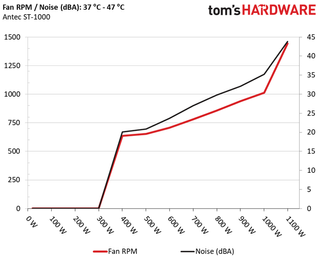
The fan speed profile remains relaxed enough, even under high operating temperatures.
The following results were obtained at 30 to 32 degrees Celsius (86 to 89.6 degrees Fahrenheit) ambient temperature.
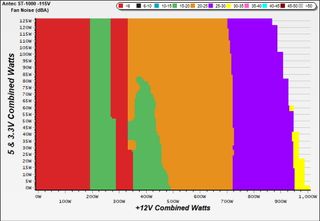

At normal operating temperatures, the PSU's fan enters the 25-30 dBA range only with higher than 720W loads. At loads close to its full capacity, >950W, the fan's noise exceeds 30 dBA. All in all, thanks to the high-efficiency levels, the fan's workload is low, so there is no need for an aggressive fan speed profile.
MORE: Best Power Supplies
MORE: How We Test Power Supplies
MORE: All Power Supply Content
Current page: Load Regulation, Hold-Up Time, Inrush Current, Efficiency and Noise
Prev Page Specifications and Part Analysis Next Page Protection Features, DC Power Sequencing, Cross-Load Tests and Infrared ImagesAris Mpitziopoulos is a Contributing Editor at Tom's Hardware US, covering PSUs.
-
refillable This is the first review I saw on the Seasonic titanum platform. Looks good on paper but I'd personally avoid it. Are you not extremely concerned about that sky-high OCP? I mean 117 A, that's huge! What if something went wrong? Wouldn't that instantly fry something? Shame Seasonic doesn't bother having multi-rail OCP on a 1000W unit. Something like the HX1000 I think is a better option with multi-rail OCP. I think 1000+ W PSUs without multi-rail OCP is just asking for trouble.Reply
I wonder why you don't seem to agree with this and instead give this thing an editor choice award. -
Aris_Mp Replyrefillable said:This is the first review I saw on the Seasonic titanum platform. Looks good on paper but I'd personally avoid it. Are you not extremely concerned about that sky-high OCP? I mean 117 A, that's huge! What if something went wrong? Wouldn't that instantly fry something? Shame Seasonic doesn't bother having multi-rail OCP on a 1000W unit. Something like the HX1000 I think is a better option with multi-rail OCP. I think 1000+ W PSUs without multi-rail OCP is just asking for trouble.
I wonder why you don't seem to agree with this and instead give this thing an editor choice award.
The HX1000 also has a single +12V rail: https://www.tomshardware.com/reviews/corsair-hx1000-psu,5214.html -
refillable Reply
No, it definitely has multi-rail OCP around 40A, a huge difference from 117A seen in this seasonic platform. You said that here:Aris_Mp said:The HX1000 also has a single +12V rail: https://www.tomshardware.com/reviews/corsair-hx1000-psu,5214.html
https://www.tomshardware.com/reviews/corsair-hx1000-psu,5214-6.html -
javiindo It would be nice to precise the use case for each power supply. Because the power supply is recommended, but you don't indicate for what. For 1000W maybe a threadripper 3990X with two 2080 ti in SLI?Reply -
waltc3 Replyrefillable said:No, it definitely has multi-rail OCP around 40A, a huge difference from 117A seen in this seasonic platform. You said that here:
https://www.tomshardware.com/reviews/corsair-hx1000-psu,5214-6.html
Yes, the Corsair HX-850 has a single/multi-rail hardware switch for either a single 72A 12v rail or else 7 40A rails...;) https://www.kitguru.net/components/power-supplies/zardon/corsair-hx850-platinum-2017-power-supply-review/3/ -
emgarf Please consider providing power-off rail sequencing as well as power-on. Both are important.Reply -
Aris_Mp Reply
LOL my bad, totally missed that :)refillable said:No, it definitely has multi-rail OCP around 40A, a huge difference from 117A seen in this seasonic platform. You said that here:
https://www.tomshardware.com/reviews/corsair-hx1000-psu,5214-6.html -
refillable Reply
So, which one do you prefer? The HX seems to as quiet despite efficiency difference, so I don't think the Titanium efficiency matters. Plus, the HX is also cheaper here and in many other countries such as the US and Australia. I think the HX is a much better choice, or at least should be honourably mentioned.Aris_Mp said:LOL my bad, totally missed that :)
